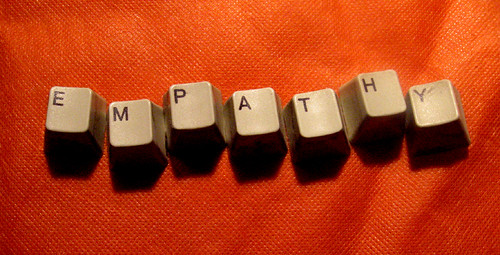 |
| flickr by @auro |
As I see it, an important tool a teacher should always have in his/her box is empathy: the ability to put himself/herself in his/her students' shoes. By doing that, the teacher is able to prepare and evaluate his/her class from both perspectives. It is through the eyes of empathy that a teacher considers his/her students' characteristics, development stage, interest, learning styles among so many other aspects. According to Jacob Moreno, the creator of Psychodrama, empathy is the ability to see the other through his/her eyes. By looking at the world from our students' perspective, we'll surely be more lenient when they text message instead of looking and paying attention to our wonderful power point presentations. We still belong to a time when students paid attention, took notes, read, and communicated. Nowadays, more is asked from us. Students are unable to stand still for more than ten minutes due to the many new cultural tools we have and the effect they have on information processing. So, empathy helps us reach the students and also respect our strengths and weaknesses. I do not mean we should let students do whatever they want to keep them motivated. The key is to use the tools that are appealing to us whenever possible.
One of the activities I usually develop on the first day of classes is to take to the classroom as many diffferent objects as possible t. Then, I display the objects and ask the students to choose one that says something about him/her. They work in pairs and later share their ideas with the whole group while I take notes as a means to use the information whenever applicable. Finally, I ask the students to choose an object they think would represent me, and they have a chance to ask me questions. Since empathy is a two-way road, it is also important to let students know something about their teacher (10 minutes).
Another idea is to include five or six pictures about my likes/dislikes, family, teaching experience, for example, in a slide (PPT) and ask students to work in groups of four and create as many questions as possible (10 minutes) to ask me. They should pay attention to their partners so as not to repeat the questions and they should also take notes about what I say. Then, it's their turn. The students draw their likes, dislikes, interests (10 minutes), show them to their partners, ask and answer questions (15 minutes) and then share their drawings and information with the whole group (10 minutes). The students can also use the I pads for this activity and prepare a slide with pictures. I'm sure I learned this activity from a teacher a the Casa in an In-Service and I apologize for not remembering his/her name to him/her credit.
As one can see, there are many activities to develop empathy in class. The most important, however, is to remember that empathy is built every single class not only on the first day.










